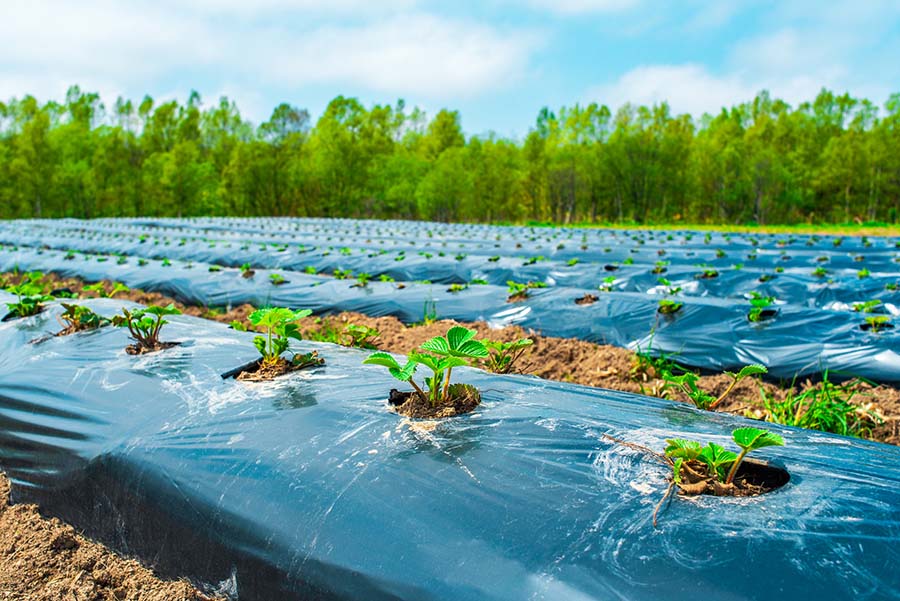The Economic & Agronomic Impact of Weed Competition in Commercial Crops.
Weed competition remains a fundamental and persistent challenge across all types of commercial farming operations, from sprawling row crops to intensive horticultural ventures. After all, weeds present a bigger problem than visual nuisances; they actively undermine crop production and farm profitability through direct and indirect effects. Let’s consider the full scope of these impacts.
From an agronomic perspective, weeds battle directly with cultivated crops for essential resources. They compete for sunlight by overshadowing smaller crop plants, for soil moisture during dry periods, and for vital nutrients intended for the cash crop. This aggressive resource theft reduces crop vigor, stunts growth, and lowers yields.
Some weed species take the battle a step further by releasing allelopathic chemicals into the soil that actively inhibit the growth of nearby crops. Dense weed infestations can alter the microclimate within the crop canopy, increasing humidity and fostering conditions favorable for plant diseases. Some weeds even serve as hosts or overwintering sites for insect pests. They can also physically interfere with critical farming operations, from planting and seedling establishment through to harvest, making each step more difficult and less efficient.
The economic consequences of unchecked weed competition are significant and often substantial. Direct costs mount quickly from herbicide purchases, labor required for manual or mechanical weeding, and fuel and equipment hours dedicated to cultivation. Beyond these out-of-pocket expenses, indirect economic losses can be even greater. Lower crop quality – such as smaller size, blemishes, or contamination with weed seeds – can drastically reduce market value and, when coupled with reduced yields, drastically impact revenue. The agronomic and economic pressures arising from an ongoing “War of the Weeds” clearly demonstrate the need for robust and sustainable weed control strategies in any commercial farming enterprise.
How Slit Film Woven Geotextiles Suppress Weeds
Understanding the significant agronomic and economic toll of weed competition naturally leads to the question: how exactly do slit film woven geotextiles combat this challenge? Like most modern weapons, their effectiveness isn’t based on a single feature but a combination of well-engineered attributes that disrupt weeds’ fundamental requirements for growth and survival.
The primary mechanism at play is light deprivation. Most weed seeds require sunlight to trigger germination, and all plants, including newly sprouted weeds, need sunlight for photosynthesis to produce energy and grow. Slit film woven geotextiles, typically opaque or dark-colored, block sunlight from reaching the soil surface. Without essential light, many weed seeds in the soil beneath the fabric simply fail to germinate. Any that do manage to sprout are quickly starved of the light needed for development and cannot survive.
In addition to blocking light, slit-film woven geotextiles present a formidable physical barrier against weed emergence. Even if a particularly determined weed seedling manages to push upwards from the soil, it meets the tightly woven structure of strong, flat polypropylene tapes. This structure physically blocks the seedling’s path to the surface, preventing it from establishing and reaching any incidental light that might filter through planting holes made for crops.
Crucially, this isn’t just a short-term fix. Durable slit film woven geotextiles are designed to provide weed control season after season with their strong, UV-stabilized polypropylene and resilient weave. Indeed, research on durable woven landscape fabrics – a category that includes quality slit film geotextiles – has consistently shown high levels of weed control efficacy. Studies have reported success rates often in the range of 92.5% to over 95% in suppressing weed cover and have demonstrated effective long-term prevention when the fabrics are correctly installed and maintained.
Applications in Perennial Systems (Orchards, Vineyards)
Perennial cropping systems like orchards and vineyards are significant long-term investments. Unlike annual crops, where fields might be tilled or replanted each year, the soil environment around established trees and vines ideally remains undisturbed for extended periods. This makes effective, long-lasting weed control critical, not just for one season but for many years to come. Slit film woven geotextiles are particularly well-adapted to meet this specific demand.
One common and highly effective application is laying ground cloth panels directly along tree or vine rows to create a clear, weed-free zone around the base of the plants where competition for water and nutrients is most critical. This placement ensures that young, establishing plants have an unimpeded start and mature plants are not stressed by nearby weeds. In systems aiming for minimal chemical input (like organic farming), those with high-density planting where inter-row cultivation is difficult, or where comprehensive ground management for site cleanliness or erosion control is a priority, geotextiles are placed to provide full floor coverage between rows. This configuration suppresses weeds across the entire area, creating cleaner conditions for maintenance, pest management, and harvest operations, and can also improve overall soil moisture conservation.
The primary advantage of slit film wovens in these perennial settings is their durability. Correctly installed, they can provide years of effective weed suppression. This longevity drastically reduces reliance on chemical herbicides, lessening concerns about herbicide buildup in the soil or potential impacts on the perennial crops themselves.
With a durable, multi-season weed blocker, the need for manual weeding or mechanical cultivation close to sensitive tree trunks or vine systems is significantly minimized, saving considerable labor, time, and fuel costs over the lifespan of the planting. In diverse ways, slit film woven geotextiles help protect the long-term health and productivity of high-value perennial crops.
Use in High-Value Specialty Crops & Permanent Bed Systems (e.g., Berries, Asparagus)
Beyond orchards and vineyards, slit film woven geotextiles provide significant advantages for many other high-value specialty crops, especially those cultivated in permanent or semi-permanent bed systems. Crops like strawberries, blueberries (often grown in raised beds or mounds), asparagus, and certain cut flowers demand pristine, weed-free conditions to maximize yield and quality. Given the high market value and often intensive labor involved with these crops, effective and long-lasting weed management is the foundation of profitability.
In bed systems, the geotextile panels are typically laid out to cover the prepared beds, with precise openings for crop plants. This establishes a dominant weed-free zone directly where the specialty crops are growing. The most immediate and impactful benefit is the maintenance of consistently weed-free conditions essential for optimal growth and maximum harvest. By eliminating weed competition from day one, young plants can establish more vigorously, and mature plants have full access to available water, nutrients, and sunlight. This is particularly crucial for low-growing crops like strawberries, where aggressive weeds can quickly smother plants, reduce fruit quality by trapping moisture or harboring pests, and make harvesting a slow, labor-intensive chore. For perennial bed crops like asparagus, the long-term weed suppression offered by durable slit film wovens means less soil disturbance and healthier root systems year after year.
The benefits extend still further. An effective, durable weed barrier in permanent beds minimizes the need for repeated herbicide applications around sensitive specialty crops and reduces hand-weeding hours. This saves on labor and input costs while supporting a clean growing environment. Ultimately, by ensuring that these high-value crops grow in an environment unhindered by weed pressure, slit film woven geotextiles help farmers protect their investment and achieve the premium yields and quality their markets demand.
What’s Next?
With clear strategies for long-term weed control using slit film woven geotextiles now in place, let’s turn our attention from what’s growing above the fabric to the environment beneath it: the soil itself. Our next chapter examines how these materials can also play a vital role in tackling issues like soil erosion, helping to manage certain soilborne stressors, and improving overall soil structure for better crop resilience.




